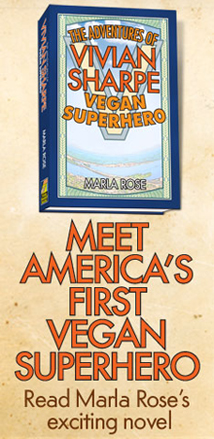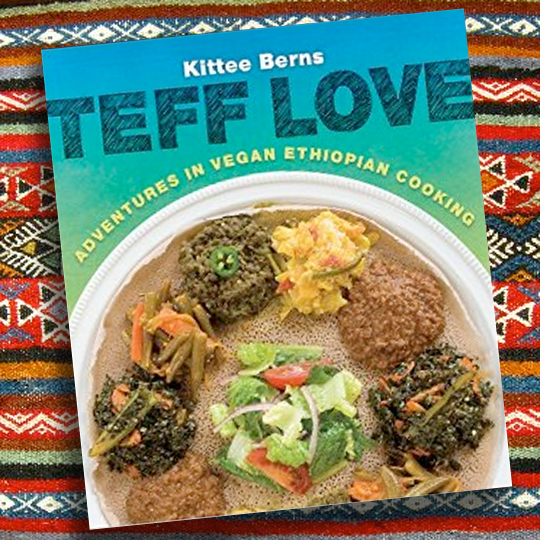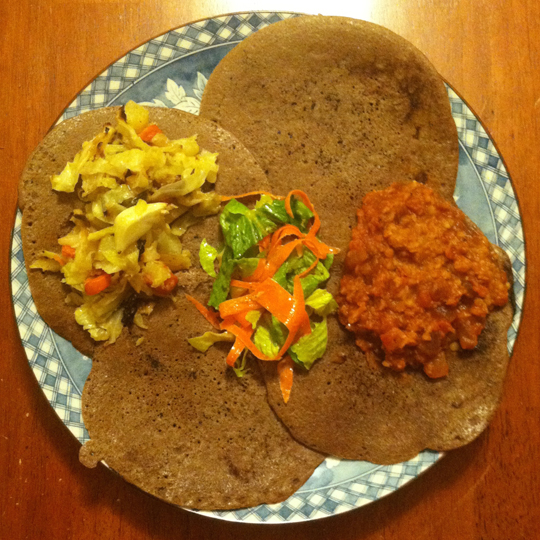
If you would prefer a printed softbound version of When Vegans (Almost) Rule the World, you can pick one up for just $11.99 at Amazon. Kindle eBook coming soon!

Available in either softbound or Kindle/Nook/etc. eBook at Amazon
viviansharpe.com

  Book Review: Teff Love by Kittee Berns review by Marla Rose When I was in high school, I was introduced to the pure sensory delight that is Ethiopian food. I was working as a vendor selling peanuts (and earning peanuts) over the summer at Cub’s games and would occasionally carpool with the Berman brothers, childhood friends of my brother, who, despite the fact that we grew up in a pretty lilywhite suburb, were passionate explorers of food from around the globe. Chicago and its abundance of ethic restaurants was just a short distance away but I never really experienced it until that summer of carpooling with the uncommonly worldly Berman brothers. Once a month or so, we would stop to get Indian food on Devon Avenue after a game, which was life-changing to me as a sheltered vegetarian teen who didn’t get many options beyond baked potatoes when dining out. Another favorite of the Berman brothers was Mama Desta’s Ethiopian restaurant on Clark Street, just south of Wrigley Field, where the Cubs play. Mama Desta’s was (and perhaps still is) a little dark and seedy for someone who came from a clean-scrubbed suburban environment but the food – oh, the food. It was a taste explosion in the best possible way. One bite of those weird sour flat breads, those creamy potatoes and carrots and tomato-y lentils, and I was hooked for life. I didn’t know flavors like those – spicy, tangy, salty, indescribably unusual but appealing – and textures like those – creamy, spongy, crispy in every bite - existed. It’s hard to not be hyperbolic but Ethiopian food felt like it nourished me on a level that I didn’t even know existed before. As silly as it sounds, I was changed from these experiences eating out and not just a little bit. That summer, I learned that there was an exciting culinary world out there for those of us who don’t eat animals. All these years later, Ethiopian food remains my favorite world cuisine. For those who love complex spices married with comfort food, it is pure bliss, and it is especially compatible to herbivorous diets. Whenever the opportunity arises, I am thrilled to eat at any of Chicago’s excellent Ethiopian options but most are not too close to me. When I learned of the new cookbook by Kittee Berns, Teff Love: Adventures in Vegan Ethiopian Cooking, I couldn’t wait to get a copy in my hands. Would I be able to recreate those flavors in my own kitchen, though? It turns out, yes, with Kittee’s able guidance, we are now all able to enjoy Ethiopian food in our own homes without any compromise. Kittee walks you through the features of the cuisine, including common ingredients (which includes what to look for in your berbere, the famous peppery spice blend of Ethiopian food), the best resources for purchasing items online, even advice on cooking for a crowd and setting up your platter. While the recipes generally include a lot of ingredients – as in keeping with this lavish cuisine – these are often ingredients used over and over in many of the dishes. Also, while many of the recipes may include a fair number of ingredients, keep in mind that Ethiopian food is peasant food in the best sense of the word: it’s comforting, unpretentious, not fussy and very easy to create at home. The true test would be the injera bread, though. After a disastrous attempt at making my own injera (the fermented, spongy native flat bread of Ethiopian food) a few years ago, I was apprehensive about trying again with Kittee’s method. As injera bread is a sourdough created with a starter over multiple days and specific conditions, there are many points where things could go wrong and any time science is introduced into a recipe, I get a little nervous. Kittee’s instructions that went with her recipe, though, were painstakingly detailed and included troubleshooting notes. From Monday until Saturday, I attended to that rising, falling, bubbling bowl of potential injera heaven in my kitchen (it really took just a few minutes a day) (I can be a little melodramatic sometimes) until finally, it was ready. And it worked. Perfectly. After six days and a fair amount of worry, praying to Hanuman, asking for guidance from the Berman brothers, positive visualizations and the occasional chant, I had perfect, delicious, amazing, restaurant-quality injera bread. This recipe is worth the price of the book alone, but thankfully there is much more. While I now know for certain that owning an Ethiopian restaurant is not one of my life’s ambitions, being able to make injera in the comfort of my own home is a worthwhile consolation price.  The meal I made from recipes in Teff Love In addition to the injera, I made ye’misser wot be ‘timatim, a.k.a., Red Lentils in a Spicy Tomato Sauce, ye’atakilt alicha (just like mom used to make), also known as Stewed Cabbage, Potatoes, and Carrots in a Mild Sauce and selata, or Simple Green Salad with Citrus Vinaigrette. Everything was aromatic, rich in flavor, easy to make and, as my husband pointed out, as delicious as anything we’ve eaten at an Ethiopian restaurant. Our son also loved the food. It was an epic Ethiopian feast from my very own kitchen, one that transported me back to that introductory meal at Mama Desta’s: love at every bite. With colorful photography, vivid descriptions, clear instructions and written with an obvious love for the cuisine, this is a cookbook for anyone who already loves Ethiopian food or is even curious about it. Packed with classic recipes as well as some fun new interpretations, such as Ethiopian-Style Hummus and Ethiopian-Style Mac ‘n’ Cheesie, Teff Love will not disappoint. Thanks so much to The Book Publishing Company for permission to reprint the following recipe from Teff Love. ye’denich be’kaysir atakilt Tender potatoes with pickled beets and onion Makes 4 cups in a lime vinaigrette 1⁄4 cup extra-virgin olive oil 1⁄4 cup freshly squeezed lime or lemon juice 1 tablespoon whole-grain mustard 1 teaspoon agave nectar 1⁄2 teaspoon salt, plus more if desired 8 ounces small red beets, roasted and peeled and cut into sticks (between 1⁄4- and 1⁄2-inch thick) 1⁄2 cup thinly sliced onion 3 thin-skinned potatoes, boiled and peeled and cut into 1⁄2-inch cubes (3 cups) Freshly ground black pepper Put the oil, lime juice, mustard, agave nectar, and salt in a me- dium bowl and stir well to combine. Add the beets and onion and stir gently to combine. Cover and let marinate in the re- frigerator for 1 to 12 hours. Put the potatoes in a large bowl and add the beet mixture. Stir gently to combine. Season to taste with pepper and addi- tional salt if desired. Cover and refrigerate until cold. Per cup: 300 calories, 4 g protein, 15 g fat (2 g sat), 38 g carbohydrates, 62 mg sodium, 37 mg calcium, 6 g fiber © 2013-2015, Vegan Street |













 |
 |
 |
 |
 |
 |
 |